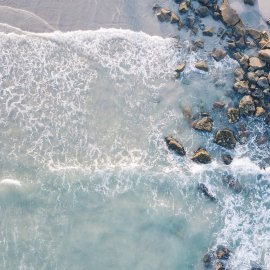Biomimicry: A Framework for the Future
-
English
-
ListenPause
Welcome to World Ocean Radio… I’m Peter Neill, Director of the World Ocean Observatory. As I consider this new year, 2018, I wonder about the ocean agenda, its substance, momentum, and role as a solution to so many challenges faced by the world. We are living in a retrogressive political time, with a deliberate strategy for reversal, indeed, for the dismantling of the environmental progress we have made since the mid- 1970s when individuals, organizations, and governments realized that indiscriminate growth in the name of consumption was despoiling the glories and utilities of Nature. We have come so far, only on the threshold of another year to understand that all that progress is to be willfully denied and subverted unless we stand up and resist in the name of ourselves, our communities, and our ensuing generations. I read this morning the thoughts that “optimism is an ethic, not an attitude.” I confess I had never thought of my personal bias toward the optimistic perspective was anything more than an innate condition. But this statement made me understand that it is more than just a worldview, rather as a certainty with compelling moral dimension. The realization gave me both pause and strength as I continue to search for the framework by which to outline the shifts in value, structure, and behavior regarding the ocean, freshwater, and all the inherent derivative benefits for food, energy, health, security, community, and civil engagement among the peoples of the earth, indeed for the future of human survival. That is what World Ocean Radio, and the World Ocean Observatory, do: we advocate for the sustainable ocean through responsible science, cultural insights, education, and public engagement. The framework I now believe is correct and logical is based on Life’s Principles as identified by the Design Lens of Biomimicry 3.8, an organization dedicated to “learning from the natural world for solutions, solved in the context of the earth’life’s genius.” What this vision does is provide an architecture for responding to our present situation by emulating natural processes as based on the following nine principles: • Nature runs on sunlight • Natures uses only the energy it needs • Nature fits form to function • Nature recycles everything • Nature rewards cooperation • Nature banks on diversity • Nature demands local expertise • Nature curbs excesses from within • Nature taps the power of limits Each of these is a quiet but absolute contradiction of our past principles as constructed post- Industrial Revolution and the presumption that humankind is superior to Nature and can manipulate it at will through extraction, pollution, and exhaustion. Well, look where that has gotten us. We’re so smart that we have with premeditation and method poisoned our land, impoverished our population, and subverted our highest aspirational values by greed, inequity, and indifference. It is a sorry plight, and it’s time to reject this system categorically lest we put our entire being in jeopardy. If you think about the Biomimicry Principles, however, you can sense an obvious path forward using the best of our hopes and achievements, though the power, efficiency, and right economy of the natural world – through the use of the sun, through limited consumption, through re-design of our questions and answers, through the re-cycling/re-use of everything we make, through cooperating not exploiting one another, through self-regulation of our unrestrained and subversive excesses, and through the understanding that limited growth in the name of sustainability is the way forward out of the historic morass in which we are now imprisoned into a world conducive to harmony and life. What the Biomimicry Life Principles provide is a new vocabulary for us to understand the virtues of Nature that we can, with moral certainty, adopt as guidelines for adapting our bankrupt conventions to new convictions, organizations, and actions. As we consider next steps for the ocean, we will do so within this new framework, relying on the ocean and her systems to lead us. And we will surely apply a tenth compelling Principle by asking: Is it beautiful? We will discuss these issues, and more, in future editions of World Ocean Radio. WORLD OCEAN RADIO IS DISTRIUTED BY THE PUBLIC RADIO EXCHANGE AND THE PACIFICA NETWORK FOR USE BY COLLEGE AND COMMUNITY RADIO STATIONS WORLDWIDE. FIND US WHEREVER YOU FIND YOUR FAVORITE PODCASTS.
What is the framework by which to outline our values, structures, and behaviors regarding the ocean, fresh water, and all the benefits of nature required for human survival? In this episode of World Ocean Radio, host Peter Neill examines this question and provides us with an overview of the Design Lens of Biomimicry 3.8, an organization dedicated to learning from the natural world in order to respond to our present day situation. He'll share the nine principles of the biomimicry architecture and argue that they provide a new vocabulary for us to understand the virtues of Nature if we are able to adopt them for a sustainable future.
About World Ocean Radio
Peter Neill, Director of the World Ocean Observatory and host of World Ocean Radio, provides coverage of a broad spectrum of ocean issues from science and education to advocacy and exemplary projects. World Ocean Radio, a project of the World Ocean Observatory, is a weekly series of five-minute audio essays available for syndicated use at no cost by college and community radio stations worldwide.
If you value World Ocean Radio, please consider becoming a Patreon Supporter today.
Image
Photo by Ruth Troughton on Unsplash
Resources from this episode
Design Lens Biomimicry 3.8
- Login to post comments



